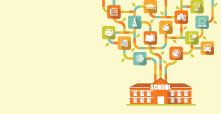Feature Facts: May 2022
Troubleshooting Emergent Issues

As microcosms of society, schools are hardly immune to the pressures in a polarized world, and the pandemic has only made that fact more apparent. When challenges arise, school leaders must act quickly to ensure the health and safety of the school community and prevent the dissemination of misinformation. School leaders can do these things more easily and efficiently with a community supporting them. Here’s how they can create such a community:
- Find others with similar professional backgrounds.
- Find a secure app well-suited to meet the needs of community members.
- Set guidelines for your community.
- Share your own experiences and build upon the experiences of others.
Rachel’s Challenge

Strengthening middle school culture is no small task. That’s why Landisville Middle School in Landisville, PA, uses the SEL program Rachel’s Challenge to prioritize student-led initiatives. The program, created by Darrell Scott, the father of Rachel, the first student killed during the Columbine High School shooting in 1999, provides schools a centralized resource to developing a caring, positive environment and includes digital resources, videos, speaker presentations, literature, and lesson plans. Authors Patrick Conrad and Attie Frey describe the specific programs they have run thanks to Rachel’s Challenge this year.
Leading a Data-Driven School

Author Marck Abraham encourages all school leaders to not only know their data but understand and own their data. He suggests that they do so using his ABC Success Method, which stands for Attendance, Behavior, and Course-Passing data. “Knowing this data allows you to understand the biggest issues within your building and can help to support initiatives that will move the school forward,” he writes. Abraham believes that taking time this summer to unpack this data will allow school leaders to focus on the needs of their schools and prepare for a successful new school year.
Change Your School’s Culture

Ensuring that students have the opportunity to set learning goals that motivate them can help shape a school’s culture. That’s why it’s important for not only teachers to help their students create goals, but for school leaders to support their teachers with goal setting. Author Chris Nordengren explains how to set up a goal-setting culture, what effective goals look like, and how to support goal setting across classrooms. “Students who are more invested in their learning make more meaningful choices about how and what they learn and better understand how to get from where they are to where they want to go.”
